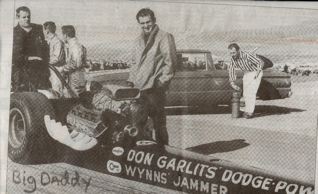Part 2
 (Photo: Don “Big Daddy” Garlits standing behind his dragster with Jim McLennan, wearing striped shirt in the background)
(Photo: Don “Big Daddy” Garlits standing behind his dragster with Jim McLennan, wearing striped shirt in the background)
For the uninitiated, drag racing is a lightning speed contest between hot rods racing side-by-side.
In the 1960s, to reach maximum speeds of more than 200-mph in less than 7 seconds, dragsters fine-tuned their engines, modified body shapes and experimented with exotic, flammable fuels.
In the drag racing world, âSeven seconds is an eternity,â? Jim McLennan told me eight years ago when he was in his mid-60s. McLennan was also the veteran of 2,000 races and the former owner of the legendary Champion Speed Shop in Colma (south of San Francisco).
âBack in the early 1950s when I was known as a hot rod kid,â? McLennan said, â I cruised in a â51 Chevy loaded with a powerful Oldsmobile engine. I was at Melâs Drive-In when a young man called âthe Greekâ pulled alongside me in his â41 Buick with a Cadillac engine.â?
âWanna drag?â? challenged âthe Greekâ.
The hot-rodders negotiated the site of their âoutlaw dragâ? before settling on the straight-away of the âUpper Great Highwayâ? near San Franciscoâs Ocean Beach.
San Franciscoâs avenues were used because âthere was no place to dragâ?, McLennan told me. âThe street machines were going faster and faster and it was getting out of hand.â?
Sometimes the âoutlaw dragsâ? took place as early as 5:30 a.m. to avoid getting âtaggedâ? or arrested by police.
Jim McLennan was 25 when he changed careers. He opened the Champion Speed Shop on Mission Road near the Holy Cross Cemetery in Colma.
Inside the concrete âtilt-upâ? building where the smell of oil permeated the air, McLennan did tune-ups—but what he relished was building hot rods from scratchâand he was so good at it that the phone rang constantly until closing time, 9 p.m. On the other end of the line were young hot-rodders asking questions about engines, ordering special parts, inquiring about the date of the next drag race.
McLennanâs Speed Shop became the nerve center for drag strip devotees.
It was one thing to build fast engines, it was another to actually own a drag strip and thatâs what Jim McLennan wanted.
He wanted to own a legal and safe place where amateurs and pros could compete. Imagine his excitement when he learned that the 3000-foot long, 60-foot wide asphalt covered auxiliary air strip at the isolated Half Moon Bay Airport was for rent.
McLennan snapped up the opportunity but he realized that attracting spectators might not be easy. He would have to overcome the fact that few people knew how to find the remote, sparsely populated Half Moon Bay.
…To Be Continued…
. Photo courtesy Mark Andermahr, HMB Bakery (When you go to buy bread or pastries, enjoy the many dragster photos on the walls of the HMB Bakery on Main Street)
